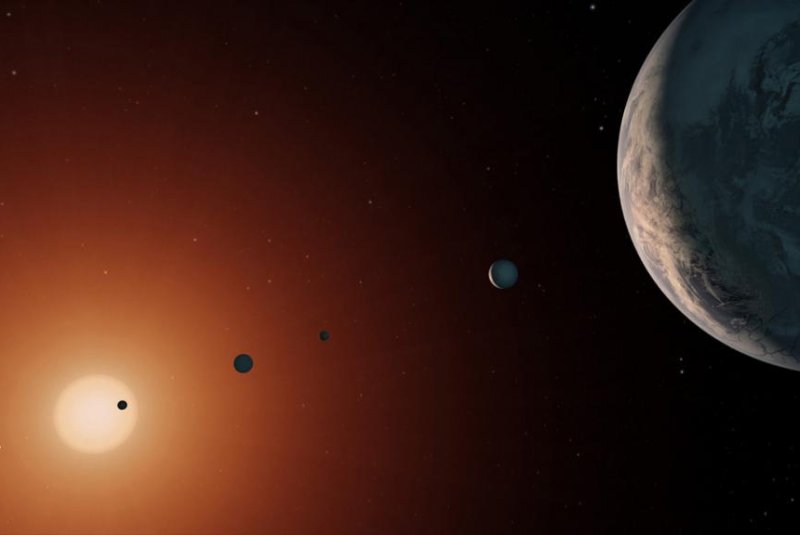New research suggests the TRAPPIST-1 system is older than our solar system. Photo by NASA/JPL
Aug. 11 (UPI) -- Astronomers have narrowed in on a more precise estimate of the TRAPPIST-1 system.
Scientists believe the star and its exoplanets are between 5.4 and 9.8 billion years old -- as much as twice as old as our solar system. The sun was born 4.5 billion years ago.
In February, NASA announced the discovery of seven Earth-sized planets orbiting TRAPPIST-1, an ultra-cool dwarf located 40 light-years away. Three of the seven planets are located within the star's habitable zone.
The habitable zone, however, doesn't guarantee habitability, it simply defines a range of orbital distances at which water could in theory exist as a liquid.
Because all seven of the TRAPPIST-1 exoplanets are bunched close to their host star, some astronomers have suggested solar flares could burn away any liquid water. Others have shared concerns that the planetary orbits of the TRAPPIST-1 system are unstable.
But the latest age estimate suggests the planetary system is relatively stable. If the planets' orbits weren't stable, the system would have likely collapsed a few billion years ago.
"Our results really help constrain the evolution of the TRAPPIST-1 system, because the system has to have persisted for billions of years," Adam Burgasser, an astronomer at the University of California, San Diego, said in a news release. "This means the planets had to evolve together, otherwise the system would have fallen apart long ago."
While it is still possible the lengthy exposure to solar radiation could have burned away the atmospheres and surface liquids on the TRAPPIST-1 planets, the new age estimates suggest the star is rather old. Aging cool dwarfs are typically less volatile and feature fewer violent flares.
The system's seniority means the planets have had plenty of time to potentially evolve life, but it also means said life would have had to survive a diverse array of disruptions.
"If there is life on these planets, I would speculate that it has to be hardy life, because it has to be able to survive some potentially dire scenarios for billions of years," Burgasser said.
Astronomers reevaluated the TRAPPIST-1's age after measuring the speed at which the system is traveling through the Milky Way. Older stars are faster. They also studied the star's atmosphere as well as the frequency of its flares. All three factors suggest the system is significantly older than our solar system.















